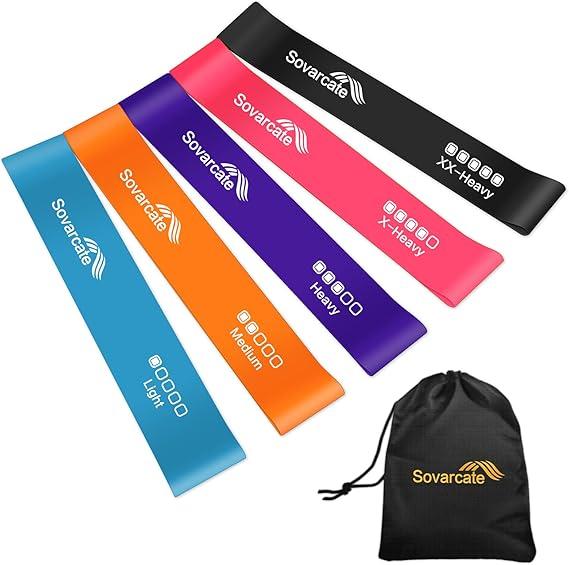In the realm of home fitness, versatility and efficiency are key, and resistance bands stand out as a powerful tool to elevate your workout routine. Whether you’re a seasoned athlete or just beginning your fitness journey, incorporating resistance bands into your home workouts can transform the way you exercise. These compact, portable bands offer a myriad of benefits, from enhancing strength and flexibility to providing a full-body workout without the need for bulky equipment. In this guide, we will explore how to seamlessly integrate resistance bands into your fitness regimen, offering expert tips and effective exercises to help you maximize your results. Embrace the potential of resistance bands and discover a new dimension of home workouts that is both challenging and rewarding.
Understanding Resistance Bands and Their Benefits
Resistance bands are a versatile and affordable addition to your home workout routine. These bands come in various levels of resistance, allowing you to gradually increase the intensity of your workouts. Why choose resistance bands? They are lightweight, portable, and can be used to target multiple muscle groups effectively. Whether you’re looking to build strength, improve flexibility, or enhance muscle tone, resistance bands can be your go-to equipment.
- Versatility: Use them for exercises like squats, lunges, and bicep curls.
- Accessibility: Perfect for all fitness levels, from beginners to advanced athletes.
- Space-Saving: Ideal for small spaces, no need for bulky gym equipment.
- Cost-Effective: A budget-friendly option compared to other fitness gear.
Incorporating resistance bands into your home workouts can revolutionize your fitness routine. By engaging your muscles differently than traditional weights, they can help you achieve a well-rounded workout. Try integrating them into your routine by replacing or supplementing exercises you already perform with free weights. Experiment with different resistance levels to challenge your body and keep your workouts dynamic and engaging.

Choosing the Right Resistance Bands for Your Fitness Level
When it comes to selecting the perfect resistance bands for your fitness routine, the key is to match the band’s resistance level with your current strength and exercise goals. Beginner exercisers should start with lighter resistance bands, typically color-coded in yellow or green, to ensure they can perform movements with proper form while building foundational strength. As you progress, gradually transition to medium resistance bands, often blue or red, to continue challenging your muscles and avoid plateaus.
- Light Resistance: Ideal for warm-ups, rehabilitation, and beginners.
- Medium Resistance: Suitable for intermediate users aiming to increase muscle endurance and tone.
- Heavy Resistance: Best for advanced workouts, focusing on building muscle mass and strength.
It’s also crucial to consider the type of band that fits your workout style. Loop bands are excellent for lower body exercises like squats and leg lifts, while tube bands with handles are versatile for upper body workouts, offering a more secure grip. Remember, quality matters; invest in durable bands that can withstand your workout intensity to maximize your fitness gains safely.

Incorporating Resistance Bands into Your Exercise Routine
Resistance bands are a versatile tool that can elevate your home workouts by adding varying levels of tension to your exercises, thereby engaging more muscle groups. Begin by incorporating them into your warm-up routine to activate your muscles. For example, use a light band for glute bridges or lateral leg raises to fire up your lower body. Once your muscles are activated, you can integrate bands into your main workout. Consider exercises such as:
- Band Squats: Loop the band just above your knees to enhance your squat by adding resistance, which helps in building stronger glutes and thighs.
- Resistance Band Rows: Secure the band around a stable post and perform rows to target your back muscles, simulating a rowing machine.
- Chest Press: Anchor the band behind you and press forward for an effective chest workout.
Utilize bands for core workouts as well. For instance, perform banded Russian twists by holding the band taut while rotating your torso to engage your obliques. The key to success with resistance bands is to maintain control and focus on the muscle groups you are targeting, ensuring that your form is not compromised by the added resistance. This approach not only boosts strength but also enhances flexibility and balance, making resistance bands an indispensable part of your home fitness arsenal.
Maximizing Results with Resistance Band Techniques
To truly enhance your home workouts, it’s crucial to understand how to effectively utilize resistance bands. These versatile tools offer a wide range of exercises that target different muscle groups, ensuring a comprehensive fitness routine. Begin by focusing on the form and control of each movement. Resistance bands provide continuous tension, which is perfect for improving strength and stability. Aim for smooth, controlled movements to maximize muscle engagement and reduce the risk of injury.
- Focus on Core Stability: Incorporate exercises like banded planks or seated Russian twists. These moves not only strengthen your core but also improve balance and coordination.
- Enhance Upper Body Strength: Try banded push-ups or standing rows. These exercises target your arms, shoulders, and back, providing a full upper body workout.
- Boost Lower Body Power: Squats and lunges with resistance bands can increase the intensity, helping to build stronger glutes, quads, and hamstrings.
By integrating these techniques, you can transform your home workouts into powerful sessions that yield noticeable results. Consistency and progression are key; gradually increase the band’s resistance level to continue challenging your muscles and enhancing your overall fitness.




